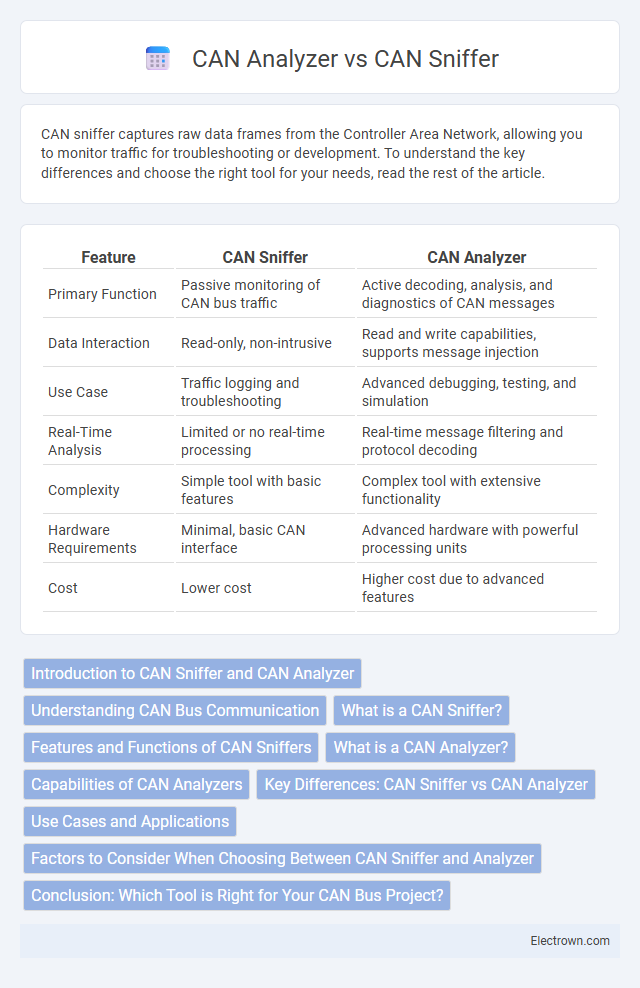CAN sniffer captures raw data frames from the Controller Area Network, allowing you to monitor traffic for troubleshooting or development. To understand the key differences and choose the right tool for your needs, read the rest of the article.
Table of Comparison
| Feature | CAN Sniffer | CAN Analyzer |
|---|---|---|
| Primary Function | Passive monitoring of CAN bus traffic | Active decoding, analysis, and diagnostics of CAN messages |
| Data Interaction | Read-only, non-intrusive | Read and write capabilities, supports message injection |
| Use Case | Traffic logging and troubleshooting | Advanced debugging, testing, and simulation |
| Real-Time Analysis | Limited or no real-time processing | Real-time message filtering and protocol decoding |
| Complexity | Simple tool with basic features | Complex tool with extensive functionality |
| Hardware Requirements | Minimal, basic CAN interface | Advanced hardware with powerful processing units |
| Cost | Lower cost | Higher cost due to advanced features |
Introduction to CAN Sniffer and CAN Analyzer
A CAN sniffer captures and logs raw CAN bus data for real-time monitoring, allowing identification of message IDs and traffic patterns without interpreting the content. A CAN analyzer provides advanced decoding capabilities, translating raw CAN frames into meaningful data by interpreting protocol layers and enabling detailed analysis of message signals and network errors. Both tools are essential for diagnosing issues in automotive and industrial CAN networks, but the analyzer offers deeper insights through protocol-aware analysis.
Understanding CAN Bus Communication
A CAN sniffer captures raw CAN bus data frames in real-time, enabling observation of message traffic without decoding or interpretation. In contrast, a CAN analyzer provides advanced functionality by decoding protocol data, filtering messages, and displaying detailed information about node interactions and error states. Understanding CAN bus communication requires recognizing that sniffers offer passive data logging, while analyzers facilitate comprehensive analysis and troubleshooting of communication between electronic control units (ECUs).
What is a CAN Sniffer?
A CAN sniffer is a diagnostic tool designed to non-intrusively capture and monitor Controller Area Network (CAN) bus traffic in real time, enabling engineers to identify communication issues and analyze messages without disrupting the network. It records data frames such as identifiers, data bytes, and timestamps, providing raw information for further analysis. Unlike a CAN analyzer, which often includes advanced features for interpreting and decoding CAN protocols, a CAN sniffer primarily focuses on data interception and logging.
Features and Functions of CAN Sniffers
CAN sniffers primarily capture and log real-time data packets from CAN bus communications, enabling detailed monitoring and troubleshooting of network traffic. Their features often include protocol decoding, timestamping, and filtering capabilities to isolate specific messages or error frames. You rely on a CAN sniffer for passive observation without interference, making it ideal for diagnostics and identifying network anomalies.
What is a CAN Analyzer?
A CAN Analyzer is a specialized tool designed to capture, decode, and interpret Controller Area Network (CAN) bus messages in real-time, providing detailed insights into network communication and device behavior. Unlike a simple CAN sniffer that passively listens to network traffic, a CAN Analyzer offers advanced features such as message filtering, error detection, and protocol analysis to troubleshoot and optimize your CAN system effectively. This makes it essential for engineers and technicians working on automotive diagnostics, industrial automation, or embedded system development.
Capabilities of CAN Analyzers
CAN analyzers offer advanced capabilities such as detailed protocol decoding, real-time error detection, and comprehensive message filtering to simplify troubleshooting in complex Controller Area Network systems. They support features like data logging, signal simulation, and timing analysis, enabling in-depth examination of CAN communication patterns and fault identification. These tools facilitate precise monitoring and diagnostics beyond basic frame capturing, making them essential for development and maintenance in automotive and industrial applications.
Key Differences: CAN Sniffer vs CAN Analyzer
A CAN sniffer passively intercepts and captures CAN bus messages for monitoring and troubleshooting, whereas a CAN analyzer actively decodes, filters, and interprets data to provide in-depth protocol analysis and error detection. Your choice between a CAN sniffer and CAN analyzer depends on whether you need simple data capture or comprehensive diagnostics with real-time insights. CAN analyzers offer advanced features like timing analysis and bus load measurement, which are typically absent in basic CAN sniffers.
Use Cases and Applications
CAN sniffers capture and monitor raw CAN bus data for real-time diagnostics, troubleshooting, and identifying communication errors in automotive and industrial networks. CAN analyzers provide in-depth protocol decoding, message interpretation, and timing analysis, facilitating comprehensive system validation, performance optimization, and compliance testing. While sniffers are essential for quick data acquisition in development and maintenance, analyzers are crucial for detailed analysis during design verification and fault isolation.
Factors to Consider When Choosing Between CAN Sniffer and Analyzer
Choosing between a CAN sniffer and a CAN analyzer depends on the depth of data inspection required and the complexity of the vehicle network being monitored. CAN sniffers offer basic frame capturing for simple diagnostics, while CAN analyzers provide advanced features like real-time data interpretation, error detection, and protocol decoding. Consider factors such as budget constraints, desired analysis capabilities, and the technical expertise available when selecting the most suitable tool.
Conclusion: Which Tool is Right for Your CAN Bus Project?
A CAN sniffer captures raw data packets from your CAN bus, making it ideal for basic monitoring and troubleshooting. A CAN analyzer offers advanced features like protocol decoding, error detection, and data logging, providing deeper insights for complex projects. Choose a CAN sniffer for simple diagnostics, but opt for a CAN analyzer when detailed analysis and comprehensive CAN bus management are essential for your project's success.
CAN sniffer vs CAN analyzer Infographic

 electrown.com
electrown.com